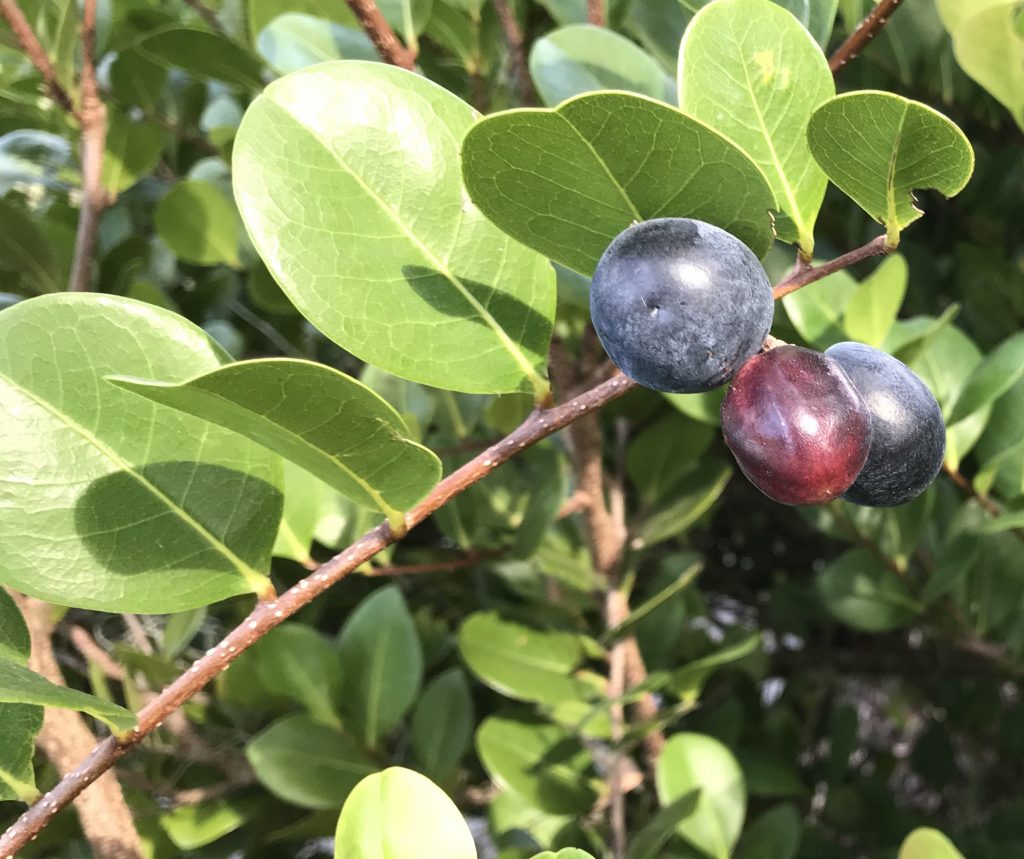
Cocoplums come in three colors. Photo by Green Deane
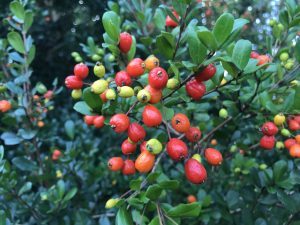
Marmalade-flavored Simpson Stopper berries. Photo by Green Deane
The fruiting of species can be a mystery. I often see a six-week difference between fruiting species in West Pam Beach and Port Charlotte, both at about the same latitude and only 120 miles apart. We saw two differences this past weekend: Cocoplums and Simpson Stopper. Cocoplums were prolific in Port Charlotte on the Gulf Coast, sporadic on the Atlantic Coast in West Palm Beach. The Simson Stoppers were the opposite, absent in Port Charlotte, ripe and ready to eat in West Palm Beach. There were also a few white Cocoplums available in West Palm Beach but only one dark purple one.
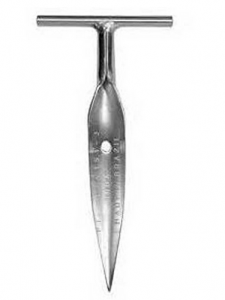
Coconut opener made by MetalCoco.
By the way there is an interesting story behind the naming of Palm Beach and West Palm Beach. It involves an insurance claim and one really big party. You can read about it an coconut oil here. I was also given a kitchen tool this past weekend related to coconuts (thank you.) I would have been a chef in another life so helpful tools are greatly appreciated. The hand on the left is an inexpensive way to tap young coconuts for their liquid. The borer is made in Brazil and sells for between $15 and $20. It doesn’t have to be sharpened but it works a little better if you put an edge on it. You pierce a soft “eye” of the coconut, rotate, and pull. Then you clean up a little debris and you’re ready to enjoy.
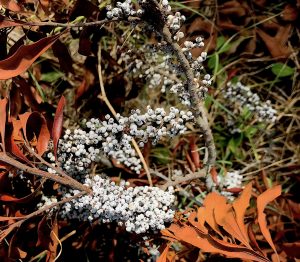
Southern Wax Myrtle berries. Photo by Green Deane
Humans often see beauty in dead plants from bouquets to Christmas wreaths. A woods road’s trimming in Spruce Creek offered us an unusual view of Southern Wax Myrtle berries. Light gray they often hide in the green aromatic leaves of this shrub. However when the trimmed leaves browned it revealed the concealed berries. They can be used as a spice when dried and put in a pepper mill. And if you have a lot of them (and the need) they also produce a green wax. If you mix that wax with one quarter tallow it makes a smokeless candle that keeps away biting insects. That chandle, however, is a lot of work. But if it is all you have to drive away insects it’s much worth it.
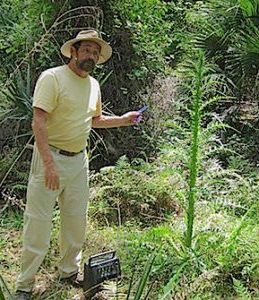
Foraging classes are held rain, shine, hot or cold. Photo by Nermina Krenata
WordPress problems last week prevented publishing a newsletter or the updated class schedule below. This time of year scheduling is tricky because of festivals and plant events. There may be some changes but it’s plotted out of a few weeks. This weekend I have classes in east Orlando and Sarasota. Maybe we’ll see some Honey Mushrooms (mentioned below.)
Saturday October 12th, Blanchard Park, 10501 Jay Blanchard Trail, Orlando, FL 32817. 9 a.m. to noon. Meet next to the tennis courts by the YMCA building.
Sunday, October 13th, Red Bug Slough Preserve, 5200 Beneva Road, Sarasota, FL, 34233. 9 a.m to noon. Meet at the swings.
Saturday October 19th, Boulware Springs Park, 3420 SE 15th St., Gainesville, FL 32641. 9 a.m. to noon. Meet at the picnic tables next to the pump house.
Sunday, October 20th, Haulover Canal, Merritt Island National Refuge, north of the Kennedy Space Center. 9 a.m. to noon. Meet at the west end of the northwest canal road. This class meets about twice a year because federal authorities can close the area without notice. This location requires the most walking.
Saturday October 26th, Wickham Park: 2500 Parkway Drive, Melbourne, FL 9 a.m. to noon. Meet at the dog park.
Sunday October 27th, Colby-Alderman Park: 1099 Massachusetts Street, Cassadaga, Fl., 9 a.m. to noon. Meet near the bathrooms.
Saturday Nov. 2nd, John Chestnut County Park: 2200 East Lake Road, Palm Harbor, FL 34685. 9 a.m. to noon. Meet at the beginning of the Peggy Park Trail inside the park.
Sunday, November 3rd, Mead Garden: 1500 S. Denning Dr., Winter Park, FL 32789. 9 a.m. to noon. Meet in the parking lot near the rest rooms.
Saturday November 9th Blanchard Park, 10501 Jay Blanchard Trail, Orlando, FL 32817. 9 a.m. to noon. Meet next to the tennis courts by the YMCA building.
Sunday, November 10th, Lake Woodruff National Wildlife Refuge, 2045 Mud Lake Road, DeLeon Springs, FL. 9 a.m. to noon. This class is rare because the federal property can be closed without notice. Meet at the first parking lot west of the railroad tracks.
Saturday, November 16th, Florida State College, south campus, 11901 Beach Blvd., Jacksonville, 32246. 9 a.m. to noon. We will meet at building “D” next to the administration parking lot.
Sunday, November 17th, Eagle Park Lake, 1800 Keene Road, Largo, FL 33771. 9 a.m. to noon. Meet at the pavilion by the dog park.
Saturday, November 23rd, Dreher Park, 1200 Southern Blvd., West Palm Beach, 33405. 9 a.m. to noon. Meet in the parking lot just north of the science center.
Sunday, November 24th, Bayshore Live Oak Park, Bayshore Drive. Port Charlotte. 9 a.m. to noon. Meet at the parking lot at the intersection of Bayshore Road and Ganyard Street. 9 a.m. to noon.
To read more about forage classes, to sign up or pre-pay go here.
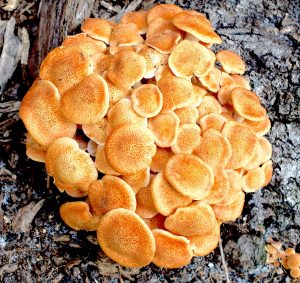
Ringless Honey Mushroom, Armillaria tabescens, Photo by Green Deane
It is close to the time for Honey Mushrooms to flush, especially as we had rain this week and are into October. Usually we start to hear reports of them in Tallahasee and Gainesville this month. Then a couple of weeks later in Central Florida and four to six weeks after that in south FLorida. They’ve already had their run this season in the Carolinas and the like. The odd thing about Honeys is while they usually have a fall flush they can occasionally pop up other times of the year. I have seen them in West Palm Beach in July. And this past year they had a spat of sightings in April and a couple in August. But, the main season is yet to come. Honey’s are fairly easy to identify being a cespitose mushroom with a white spore print. What is cespitose? You can read about it here.
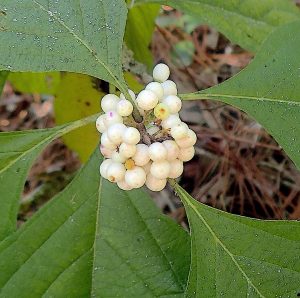
White Beautyberries. Photo by Green Deane
Are the berries to the left edible or not? Ninety-nine plus percent of white berries are not edible. White berries are a huge warning flag saying stay away. But there are exceptions. I can think of a few wild white berry species in the world that are edible, some in North America and one in Africa. But what of the berries pictured left? They are white American Beautyberries. Usually they are magenta when ripe. These are stark white. I have eaten a few. They taste like the colored ones. A few years ago I had a woman in New Jersey write to me and report she eats them all the time and makes jelly out of them. That’s not an official endorsement but it is about as close as one can get to knowing if they are edible. There are at least four species of Beautyberries that can spontaneously produce white berries, and there might be a man-made cultivar or two. I see them most often in the Spruce Creek area of FLorida. To read more about them click here.
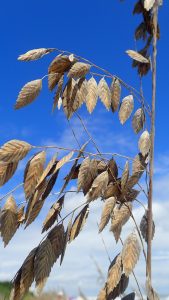
Sea Oats. Photo by Green Deane
The grain pictured right, Uniola paniculata, is edible though it does not produce a lot of seed. It is also protected. It’s not protected because it is rare. In fact it’s very common. But the plant’s roots helps keep Florida’s coastal dunes in place thus Sea Oats are protected. These were seen growing in Melbourne, Florida, near Patrick Airforce Base. I have known some folks to grow Sea Oats in their backyard as a long-lived perennial grass. They are very drought tolerant and highly regarded by browsing animals, such as deer, but are lowly regarded by grazing animals such as cows. As Sea Oats are protected you might want to find a similar looking relative in the forests of Florida. They are called… Wood Oats… not too imaginative. We saw some this past weekd during a foraging class in Port Orange. Wood Oats are edible as well and not protected. Use them as you would cultivated oats. They are easy to identify: They look like Sea Oats just in the wrong place. To read about Sea Oats click here.
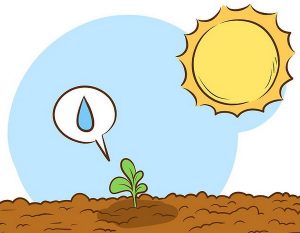 Donations: I had a $100 donation last week. Thank you very much. It was timely as WordPress went down for several days. If anyone would like to donate to this website and newsletter they can use this Go Fund Me link, this PayPal donation link or by writing to Green Deane POB 941793 Maitland FL, 32794. Again, thank you.
Donations: I had a $100 donation last week. Thank you very much. It was timely as WordPress went down for several days. If anyone would like to donate to this website and newsletter they can use this Go Fund Me link, this PayPal donation link or by writing to Green Deane POB 941793 Maitland FL, 32794. Again, thank you.

Foraging DVDs make a good gift to watch during the lifeless months of winter.
All My Videos are available for free on You Tube. They do have ads on them so every time you watch a Green Deane video I get a quarter of one cent. Four views, one cent. Not exactly a large money-maker but it helps pays for this newsletter. If you want to see the videos without ads and some in slightly better quality you can order the DVD set. It is nine DVDs with 15 videos on each for a total of 135 videos. Many people want their own copy of the videos or they have a slow service and its easier to order then to watch them on-line. The DVDs make a good gift for that forager you know especially as spring is … springing. Individual DVDs can also be ordered or you can pick and choose. You can order them by clicking on the button on the top right hand side of this page (if your window is open wide enough.) Or you can go here.
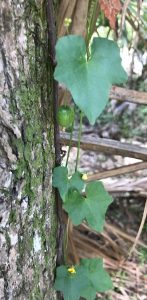
Do you recognize the edible species on the left? If you read the Green Deane Forum you would. Perhaps you’re looking for a foraging reference? You might have a UFO, an Unidentified Flowering Object you want identified. On the Green Deane Forum we — including Green Deane and some 8,000 others from around the world — chat about foraging all year. And it’s not just about warm-weather plants or just North American flora. Many nations share common weeds so there’s a lot to talk about. There’s also more than weeds. The reference section has information for foraging around the world. There are also articles on food preservation, and forgotten skills from making bows to fermenting food.
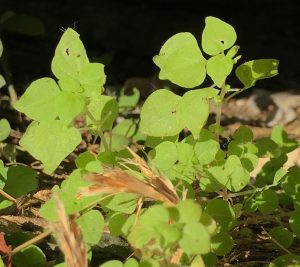
First Cucumber Weed of the season. Photo by Green Deane
And in the “for what it’s worth” department we have my first sighting of a winter edible, Pellitory. This shade-loving annual shows up when fall weather starts and stays around until at least mid-spring. Some years in very shady places you can find old straggling specimens as late as July. It smells and tastes like cucumber thus is also called Cucumber Weed. Look for it in dark places. The photo to the right was taken under a porch. To read more about this winter comestible go here.
This is weekly newsletter 375. If you want to subscribe to this free newsletter you can find the sign-up form in the menu at the top of the page.

